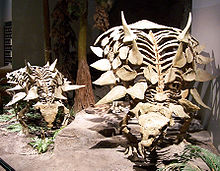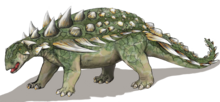Polacanthinae
Genres de rang inférieur
- † Gargoyleosaurus
- † Gastonia
- † Hoplitosaurus
- † ? Mymoorapelta
- † Polacanthus
- † Taohelong
Les Polacanthinae (polacanthinés en français), constituent une famille éteinte de dinosaures ornithischiens herbivores appartenant à l'infra-ordre des ankylosauriens et à la famille des Nodosauridae. La position de ce taxon n'est pas encore fixée et il pourrait s'agir d'une famille appelée alors les Polacanthidae (polacanthidés)[3],[4],[5],[6].

Ils ont vécu du Jurassique supérieur jusqu’au Crétacé inférieur. Le genre Polacanthus lui a donné son nom.
Description
[modifier | modifier le code]Les polacanthinés possèdent une armure plus légère que la plupart de celles des autres ankylosauriens. Leurs plaques et leurs pointes sont composées d'os plus minces que ceux des nodosauridés fortement blindés[7]. La fragilité relative de leur armure suggère que son rôle pouvait être plus de parade ou de reconnaissance dans le groupe que pour sa défense[7].
Classification
[modifier | modifier le code]Historique
[modifier | modifier le code]La famille des Polacanthidae a été érigée par George Reber Wieland en 1911 pour placer des ankylosauriens qui paraissaient avoir des caractéristiques intermédiaires entre celles de ankylosauridés et celles des nodosauridés. Ce taxon a été réactivé en 1998 par le paléontologue américain James Kirkland, mais comme une sous-famille des Nodosauridae, les Polacanthinae[8], en reprenant la dénomination établie par A.-F. de Lapparent et R. Lavocat en 1955[2]. Kenneth Carpenter définit les Polacanthidae comme tous les dinosaures plus proche de Gastonia que de Edmontonia ou Euoplocephalus[3]. Une étude complète des relations phylogénétiques des Polacanthidae, réalisée en 2012 par R. S. Thompson[4] ne tranche pas complètement entre une famille regroupant les nodosauridés primitifs ou une sous-famille de nodosauridés. En 2013, l'ankylosaurien chinois Taohelong jinchengensis est placé par ses inventeurs dans la sous-famille des polacanthinés[6].

Références
[modifier | modifier le code]- (en) G. R. Wieland. 1911. Notes on the armored Dinosauria. The American Journal of Science, series 4 31:112-124
- Lapparent A. F. De & Lavocat R. 1955. — Dinosauriens, in Piveteau J. (ed.), Traité de Paléontologie. Tome 5. Masson & Cie, Paris: 785-962
- (en) Carpenter K, The Armored Dinosaurs, Indiana University Press, , 455–484 p. (ISBN 0-253-33964-2), « Phylogenetic analysis of the Ankylosauria »
- (en) Thompson, R.S., Parish, J.C., Maidment, S.C.R. and Barrett, P.M., « Phylogeny of the ankylosaurian dinosaurs (Ornithischia: Thyreophora) », Journal of Systematic Palaeontology, vol. 10, no 2, , p. 301–312 (DOI 10.1080/14772019.2011.569091)
- (en) Kirkland JI, Alcalá L, Loewen MA, Espílez E, Mampel L, Wiersma JP (2013) The Basal Nodosaurid Ankylosaur Europelta carbonensis n. gen., n. sp. from the Lower Cretaceous (Lower Albian) Escucha Formation of Northeastern Spain. PLoS ONE 8(12): e80405. https://doi.org/10.1371/journal.pone.0080405
- (zh) Jing-Tao, YANG & You, Hai-Lu & Li, Da-Qing & De-Lai, KONG & Palasiatica, Vertebrata. (2013). First discovery of polacanthine ankylosaur dinosaur in Asia. Vertebrata Palasiatica. 51
- (en) S. Hayashi, K. Carpenter, T.M. Scheyer, M. Watabe et D. Suzuki, « Function and evolution of ankylosaur dermal armor », Acta Palaeontologica Polonica, vol. 55, no 2, , p. 213–228 (DOI 10.4202/app.2009.0103)
- (en) Kirkland, J. I. 1998. A polacanthine ankylosaur (Ornithischia: Dinosauria) from the Early Cretaceous (Barremian) of eastern Utah. New Mexico Museum of Natural History and Science Bulletin, 14, 271–281, url=https://books.google.fr/books?hl=en&lr=&id=yF4fCgAAQBAJ&oi=fnd&pg=PA271&ots=beIX9jjsaD&sig=VEPue2otO13AiB9o8A9W3q8hd0E&redir_esc=y#v=onepage&q&f=false
Voir aussi
[modifier | modifier le code]Références taxinomiques
[modifier | modifier le code]- (en) Référence Paleobiology Database : Polacanthidae Wieland, 1911
Annexes
[modifier | modifier le code]Articles connexes
[modifier | modifier le code]Text is available under the CC BY-SA 4.0 license; additional terms may apply.
Images, videos and audio are available under their respective licenses.

